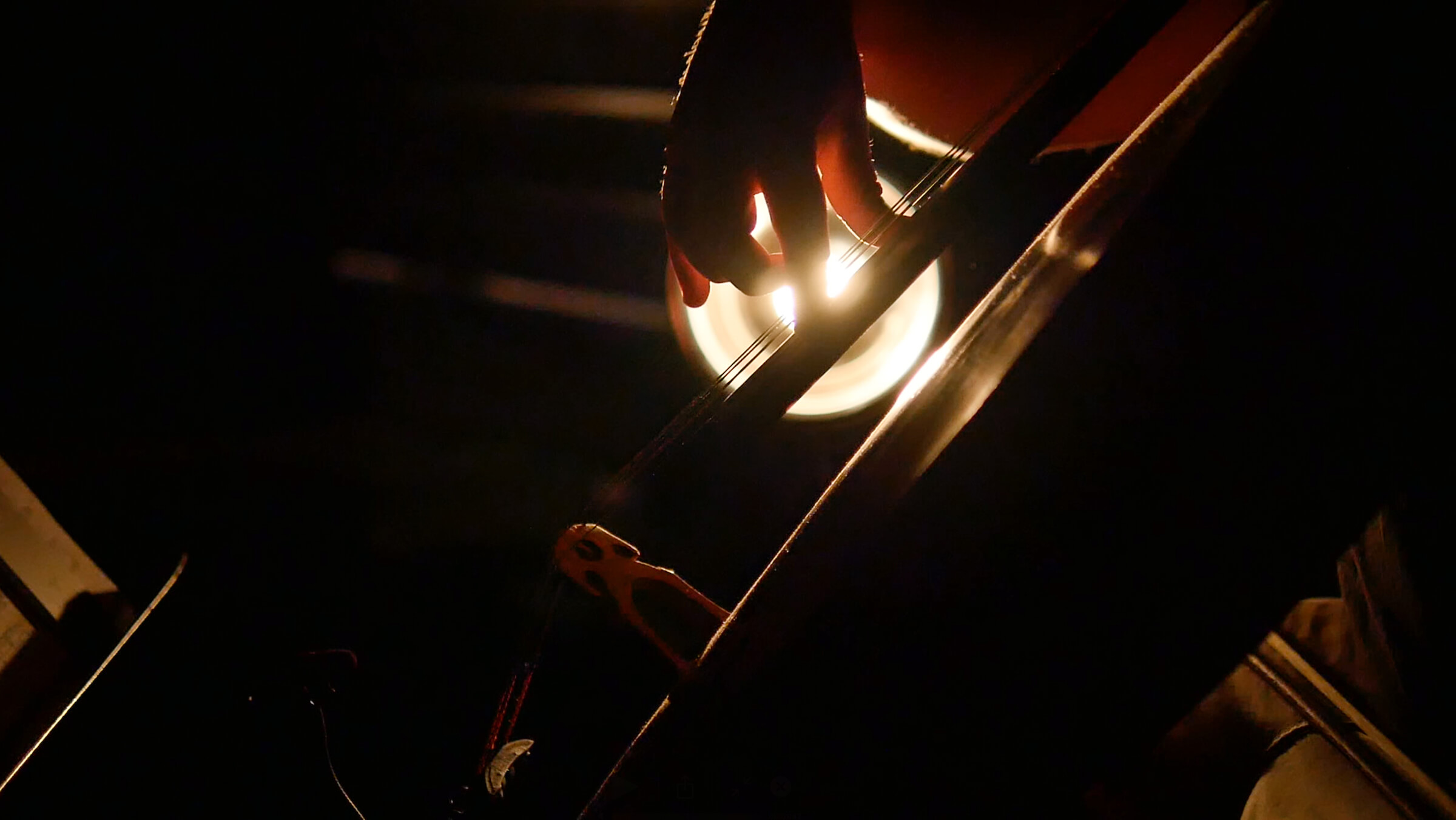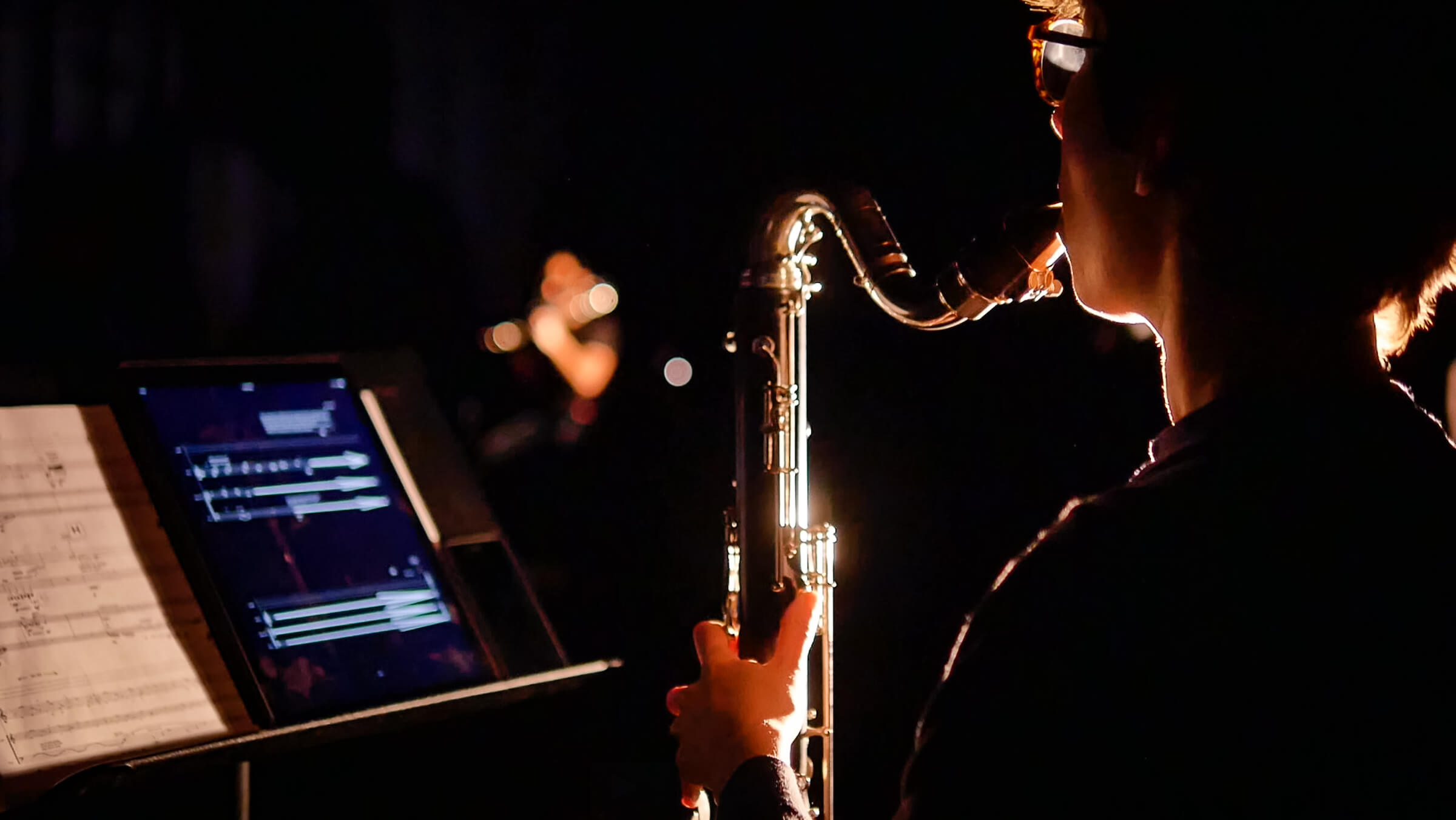Interview with Katharina Rosenberger - Part I of II
Madison Greenstone
February 2020
“I think we can’t communicate enough to the audience, to give some insight to the work processes—the conversations we have, the difficulties that come up that make us adjust things… It’s always my conviction that the result is not the piece; the piece is everything that we find out together: detours we need to take; things we find out don’t work so well… it’s all part of the piece, so to document this is really vital. Every iteration afterwards bears a mark of the process that went into it. So, even this conversation!”
– Katharina Rosenberger
After [Switch~]’s residency at UC San Diego, [Switch~] clarinetist Madison Greenstone sat down with Katharina Rosenberger to talk about her artistic projects, her piece Up Close, and her collaborative time with us. Enjoy part 1 of this 2-part interview!
Madison Greenstone: To start, could you give an overview of Up Close? A map of the piece, and what it involves in terms of stage settings, lights and amplification?
Katharina Rosenberger: I can start with the initial ideas. I really wanted to draw in the audience as closely as possible to the sound: to the sound production of physical gestures when you perform and to physical elements of the instruments—that they become part of the sound and of the music. Not just as an effect, but as material.
So, that’s where the need for amplification comes from. That led to a search for “how do I best amplify the performer?” then, along with that, a further focus on, “can I see what is performed, or can I just hear what is performed?” There is a certain intensity if you listen to acousmatic music; since you don’t see, you yourself have to approach the sounds as much as possible to grasp them. Of course, in the performance of Up Close, when at times the ensemble plays in complete darkness, you know that the performers are there. You might see a silhouette, or not: but still, it becomes much more challenging to organize your understanding of the piece or where the sound is coming from, if you don’t see it.

With the exposure of the lights, you have an initial “zoom” or focus on the instrument. Then later on in the piece I wanted to be much more playful with it. There’s a performer illuminated who’s actually not playing, or just turning the page: that’s you [addressing Madison], for instance. Or is just waiting, or adjusting the instrument… and then at the end of the piece, the light is there to play along with dynamics. So when everybody swells to a forte, the light comes on and goes away. So, it’s not about directing the listener to what’s happening with one performer, rather it’s glued to the music.
Those are some different modalities for how sound works, with the piece. From there, I began to add in further complex detail in the Experimental Theater, where we had the chance to work for 5 days together.
MG: Wait, two days.
KR: Really?
MG: We got five days of work done in two days!
KR: [laughs] Oh, wow, that’s right. We could have had double as much time to try out different options!
But coming back to the lights, it’s complicated for the audience members. They don’t see all the musicians at once. You can hear all of them, but you can’t see. I think the audience member has to be very active in the piece—very participatory. So, that is part of the setting. Then, the question is, what kind of music can I write that works within that setting? One thing, of course, was timbral nuance. On one hand, it gives the performers the chance to sculpt the sound—in miniscule ways, from one moment to the next, hoping the audience can catch on to the amplification of these changes in sounds. And… on the other hand, the materials should have a fluidity to them, particularly in terms of rhythm.
There are moments where this fluidity is contrasted and there are extreme details of how you interlock with each other. But, then the parts are taken apart, and there’s more leeway and fluidity to play these rhythms off from each other. The performers have to be really engaged and listening.
MG: Right. So, the performers have to be engaged and listening in enacting this form. Like, in real time reacting to the other person’s amplification, reacting to how they place things in time, even if we can’t see them during certain parts. And I think flexibility in time and indeterminacy in notation are really legible in the music of yours that I’ve encountered, and in Up Close. There’s this flexibility and indeterminacy in the notation itself.
KR: That’s right. Of course that does encourage precisely what we were talking about. For a long time this aspect has been a part of my work. If I think about when I was a student, the pieces I was writing, I was always looking for a flexible form that really captures the moment and the people involved in it. Maybe pieces where the individual instruments have their own timelines, so they’re not coordinated in time. Or they can pick different movements, or reorganize sections.
Or, in an installation it’s the visitor that creates the unfolding of elements… what does it mean? How does a piece need to work formally or structurally to allow that? It’s an ongoing process for me, now, over ten years. By the time we’re doing Up Close I’m not an expert on it, because things always change, or there are new elements I draw in. Playing in darkness, where you orient yourself by your ear, for example. It’s always new territory, which I’m scared of – but I’m so drawn to it. I think I could not just re-do things I know well.
I was really impressed with how all of you worked through the material. It’s not just one person! There are four more people in the music that you have to include into your playing. You look at the score and it’s all presented, and you see it’s also very plastic—like, plasticity. It’s not a flat representation: you perceive the music in a different way. It comes from far away… some performers are closer than you… you’re in this sculpture of sound.
I’m trying to write an essay about works with time-based media. You know, particularly a musical performance is always in flux. There’s not a moment where you say, “that’s the piece.” Because every performance is a little different. Spaces matter, audience matters, interpretations of the musicians or ensembles… there is never a set-in-stone piece—which I really find fascinating.
MG: I think this is a really salient part of this piece, in that the amplification and the lights are all spatialized. We’re around an audience, and then you’re composing a dynamic orchestration with the amplification. And because it’s traveling around the space, by our own control, it becomes kind of like a moving sculpture in time.
KR: It absolutely is. It’s absolutely that. Yes, the excitement is: how can the sculpture vary from time to time?
This is the difficulty, of course, as well: basically Jason and I would need to sit (in) the middle, too. But then it’s very invasive. In the middle should be the space for the audience members, but not us with our cables and lights. But, we need to hear it! We need to hear how the audience does. We have a challenge… it’s fragile, as well, the sonic image and the balance, and the orchestration of it.
MG: Well, the techniques are very fragile: very inner, and ephemeral and unstable.
KR: And that’s also something I love a lot. You know, I can’t control everything, but maybe you as a musician or an ensemble can control everything, so what happens with that quality of sound that is unstable? It’s present, but then it drifts away? We can never put our hands on it and say “you belong to me!” [laughs] This is how you have to sound!”
In a way, what we create is really this enormous offering in the moment, of possibilities—but also of counter-forces. Of sounds that withdraw themselves from this sculpture. I like that idea a lot.

MG: With everything complete, what do you hope the audience takes away? When these things are disappearing and ephemeral, how does one hold on to it?
KR: Yeah… I really hope that the piece becomes a very physical and literal experience, not just an event of appreciation—”oh, this is how I hear the music, this is how I understand it and imagine it.” There is much more to it, with the audience and the interaction. There is never such a stable moment. It’s always a negotiation. The audience is part of it: how they understand it. How they think the sounds are supposed to be there. And also for the audience to let go, as well. And understand, this is an art form we can never fully just grasp and put in our pocket and go home with. It’s always, in the end, a memory. Even when you sit there, what happens before, what is happening just now, what comes next—you can never 100% put your finger on it and say “that’s what happened”. It’s its own being—a sculpture, as you call it—that we are involved with.
MG: I think that’s really typified by the audience, sitting in the middle, all facing different directions. What is physically in front of someone could be perceived as behind someone else. Everyone, in terms of where they’re sitting or their position in the space, has this radically personal and different experience of literal orientation within the piece—and orientation of listening.
KR: You know, in a way, in time-based media, often what you hear can never be fully complete. It happens in time: you see it just from one perspective. The piece is maybe not notated how the composer is thinking, or what the performers are rendering. It’s always also an attempt—or a willingness to get as close to the artistic thought of what the piece could be. But we could never fully promise that that’s the complete and full music. And, in a way, potentially, if you think where the audience members were sitting: everybody heard it from a different angle. What does that mean overall? Everyone together, maybe, all the listening experiences: we might maybe, potentially think of a completeness of what that piece could be. Hypothetically, maybe!
But thinking at least only from the angle of the perception of the piece—that offering that the performers can give—how you can hear it, maybe of a completeness, through the different angles. We don’t know, and that’s the beauty of it.
[Switch~] will be performing Up Close at the Eastman School of Music on March 18 and at the DiMenna Center for Classical Music in New York City on March 21. To learn more and buy tickets for the NYC performance, please visit the link here. This project made possible by the kind support of New Music USA, Pro Helvetia, the Swiss Arts Council, and the Ernst von Siemens Musikstiftung.